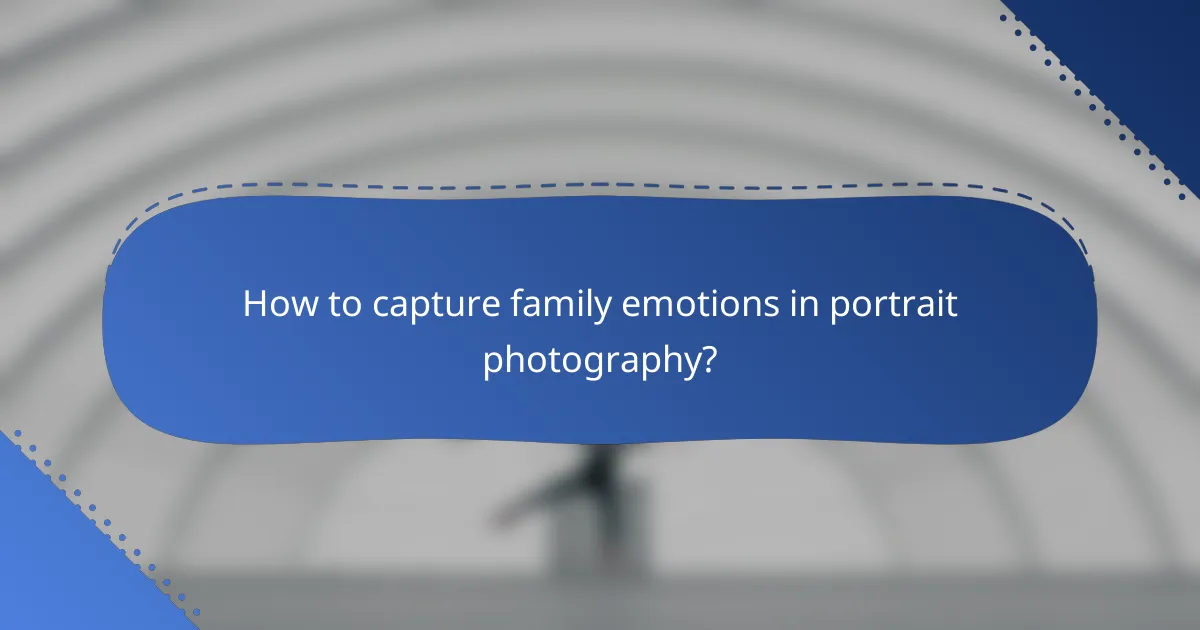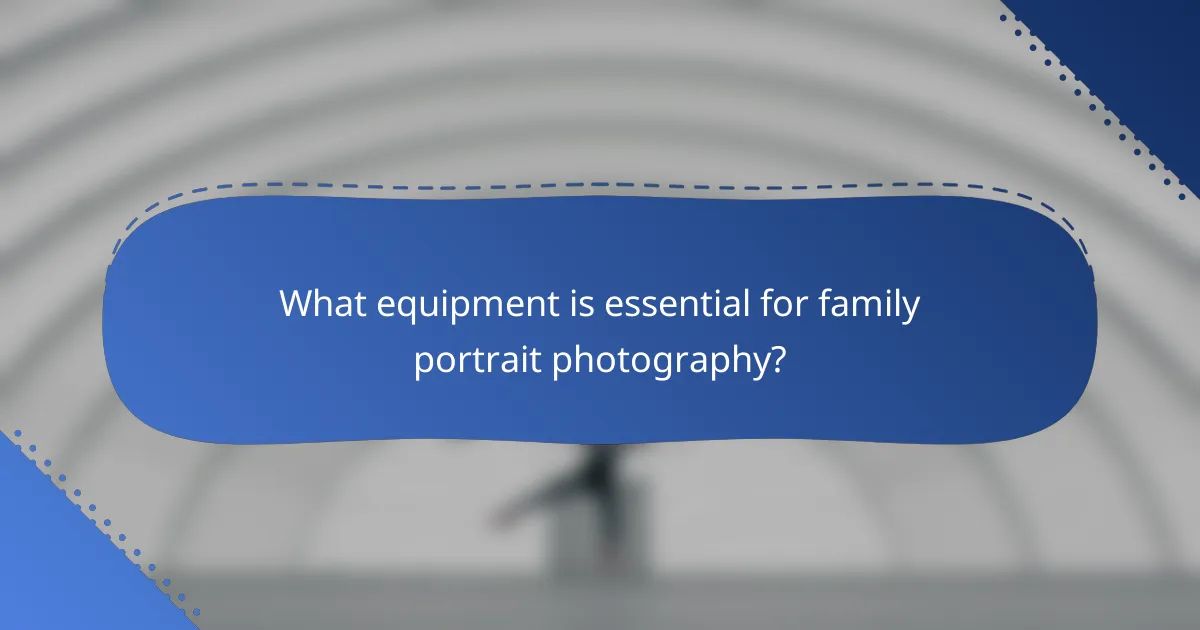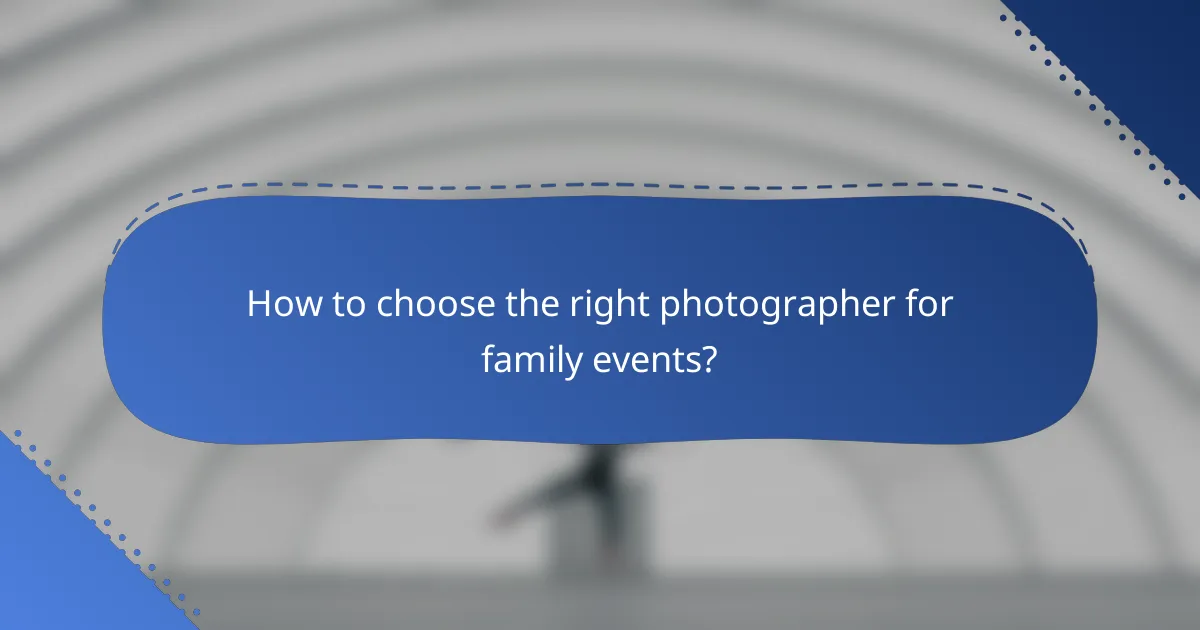Portrait photography of family events is a powerful way to capture genuine emotions and create lasting memories. By fostering an environment that encourages authentic interactions, photographers can document the unique connections and stories that define each family. Utilizing the right techniques and equipment ensures that these moments are preserved beautifully for years to come.

How to capture family emotions in portrait photography?
Capturing family emotions in portrait photography involves creating an environment where genuine feelings can surface. This can be achieved through a combination of candid moments, personal stories, and thoughtful engagement with subjects.
Use candid moments
Candid moments are often the most authentic representations of family emotions. Instead of posing everyone, allow interactions to unfold naturally, capturing laughter, hugs, and spontaneous reactions.
To enhance candid shots, consider using a longer lens to maintain distance, allowing subjects to feel at ease. This approach often results in more genuine expressions and interactions.
Incorporate personal stories
Integrating personal stories into your photography can evoke deeper emotions. Before the session, ask family members about their favorite memories or traditions, and encourage them to share these stories during the shoot.
For example, if a family has a beloved pet, capturing moments with the pet can add a layer of sentimentality. These narratives can guide your composition and help you capture meaningful interactions.
Utilize natural lighting
Natural lighting enhances the emotional quality of portraits. Soft, diffused light, such as that found during golden hour, can create a warm and inviting atmosphere.
Avoid harsh midday sun, which can create unflattering shadows. Instead, seek shaded areas or shoot during early morning or late afternoon for the best results.
Engage with subjects
Engaging with your subjects is crucial for capturing authentic emotions. Take the time to converse with family members, making them feel comfortable and valued.
Use humor or ask open-ended questions to elicit genuine reactions. The more relaxed they feel, the more likely you are to capture true emotions in your portraits.
Choose meaningful locations
Selecting locations that hold significance for the family can enhance emotional resonance in portraits. Whether it’s a favorite park, home, or a place tied to cherished memories, these settings can evoke strong feelings.
Consider the backdrop’s relevance and how it complements the family’s story. A familiar environment can help subjects feel more at ease, leading to more authentic expressions and interactions.

What are the best techniques for family event photography?
The best techniques for family event photography include careful planning, capturing genuine interactions, experimenting with different angles, and incorporating props. These methods help create memorable images that reflect the emotions and connections within the family.
Plan group shots
Planning group shots is essential for family events to ensure everyone is included and positioned well. Consider the size of the group and the location; larger groups may require a wider lens or a higher vantage point. Create a shot list to keep track of different combinations of family members.
When arranging people, use a pyramid structure or staggered heights to create visual interest. Position taller individuals at the back and shorter ones in front, ensuring everyone is visible. This approach enhances the overall composition of the photograph.
Focus on interactions
Focusing on interactions captures the genuine emotions that define family events. Look for candid moments where family members engage with each other, such as laughter, hugs, or shared stories. These spontaneous shots often convey more emotion than posed pictures.
To capture these interactions effectively, stay alert and ready to shoot. Use a fast shutter speed to freeze moments in time, and be patient; the best interactions often happen unexpectedly. This technique helps create a narrative of the event through your images.
Experiment with angles
Experimenting with angles can add depth and creativity to family event photography. Try shooting from different heights—kneeling for low shots or standing on a chair for a bird’s-eye view. This variation can change the perspective and make the images more dynamic.
Additionally, consider using leading lines or framing elements in the environment to guide the viewer’s eye. This technique can enhance the composition and draw attention to the subjects. Don’t hesitate to take multiple shots from various angles to find the most compelling view.
Incorporate props
Incorporating props can add a personal touch to family event photography. Items like blankets, signs, or favorite toys can enhance the theme of the event and make the photos more engaging. Choose props that resonate with the family’s personality or the occasion.
When using props, ensure they complement the subjects rather than distract from them. Arrange them thoughtfully within the frame, and encourage family members to interact with the props for more natural-looking photos. This approach can help create a fun and memorable atmosphere in your images.

What equipment is essential for family portrait photography?
Essential equipment for family portrait photography includes a reliable camera, appropriate lenses, lighting tools, and a sturdy tripod. These tools help capture the emotions and memories of family events effectively, ensuring high-quality images that last a lifetime.
DSLR or mirrorless camera
A DSLR or mirrorless camera is crucial for family portrait photography due to its superior image quality and versatility. These cameras allow for interchangeable lenses, manual settings, and better low-light performance, which are essential for capturing candid moments during family gatherings.
When choosing between a DSLR and a mirrorless camera, consider factors like size, weight, and battery life. Mirrorless cameras tend to be lighter and more compact, while DSLRs often offer longer battery life and a wider selection of lenses.
Prime and zoom lenses
Using prime and zoom lenses can significantly enhance your family portraits. Prime lenses, with fixed focal lengths, typically offer better sharpness and wider apertures for beautiful background blur, ideal for isolating subjects.
Zoom lenses provide flexibility, allowing you to adjust your framing without moving. A versatile zoom lens, such as a 24-70mm, is often recommended for family events, as it covers a range of focal lengths suitable for both group shots and individual portraits.
External flash or reflectors
External flashes and reflectors are essential for managing lighting in family portrait photography. An external flash can help illuminate subjects in low-light conditions, while reflectors can bounce natural light onto your subjects, softening shadows and enhancing their features.
When using an external flash, consider using diffusers to soften the light and avoid harsh shadows. Reflectors come in various colors, such as silver, gold, and white, each providing different effects on skin tones and overall ambiance.
Tripod for stability
A tripod is vital for ensuring stability during family portrait sessions, especially in low-light situations or when using longer exposure times. It helps prevent camera shake, resulting in sharper images.
When selecting a tripod, look for one that is sturdy yet lightweight for easy transport. A tripod with adjustable height and a quick-release plate can make it easier to switch between different shooting angles and compositions during family events.

How to choose the right photographer for family events?
Selecting the right photographer for family events involves assessing their experience, style, and client feedback. A good photographer should resonate with your vision and be able to capture the emotions and memories that matter most to you.
Review portfolios
Start by examining the photographer’s portfolio to get a sense of their style and expertise. Look for consistency in quality and the ability to capture candid moments, as these are crucial for family events.
Pay attention to the types of events they have previously covered, such as birthdays, reunions, or weddings, and ensure their work aligns with your expectations. A diverse portfolio can indicate versatility and adaptability to different settings.
Check client testimonials
Client testimonials provide valuable insight into the photographer’s professionalism and reliability. Look for reviews that highlight their ability to connect with families and create a comfortable atmosphere during shoots.
Consider checking multiple platforms, such as social media, Google reviews, or photography websites, to gather a well-rounded perspective. Positive feedback from previous clients can significantly influence your decision.
Discuss style and approach
Initiate a conversation with the photographer about their style and approach to family events. Understanding whether they prefer posed shots or candid photography can help you determine if they align with your vision.
Ask about their methods for capturing emotions and how they handle group dynamics. A photographer who is adaptable and communicative will likely produce better results during your event.
Evaluate pricing and packages
When evaluating photographers, consider their pricing and the packages they offer. Prices can vary widely based on experience, location, and the services included, so it’s essential to understand what you are paying for.
Look for packages that include a range of options, such as digital images, prints, or albums. Ensure that the package meets your needs and budget, and don’t hesitate to ask about any additional fees that may apply.
